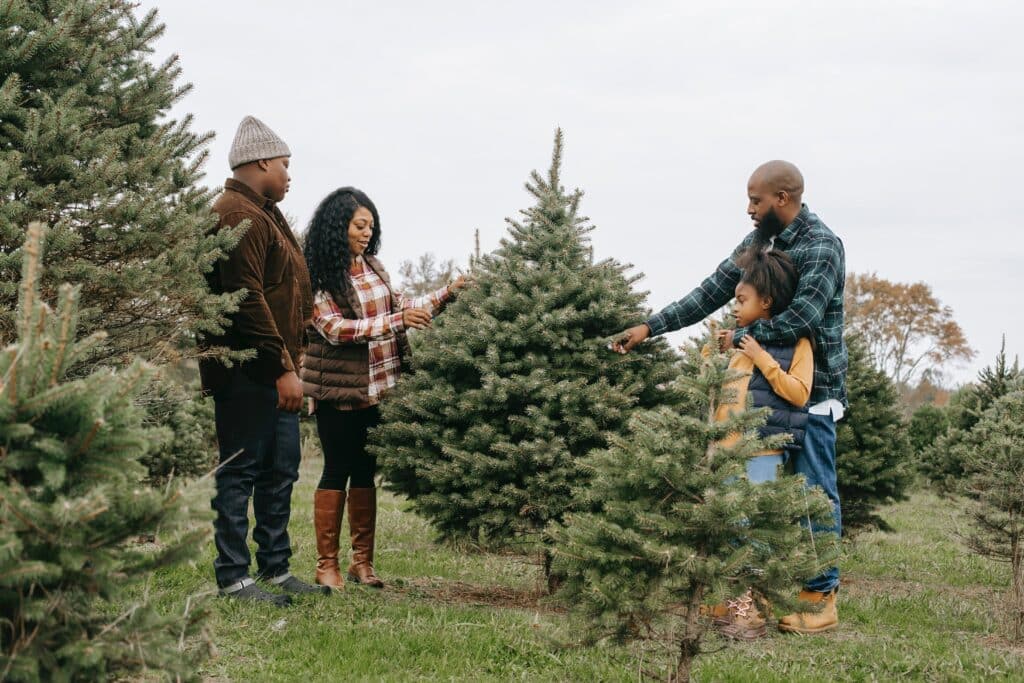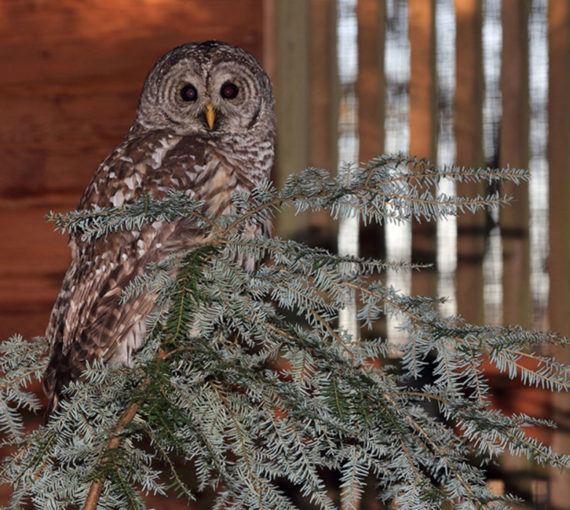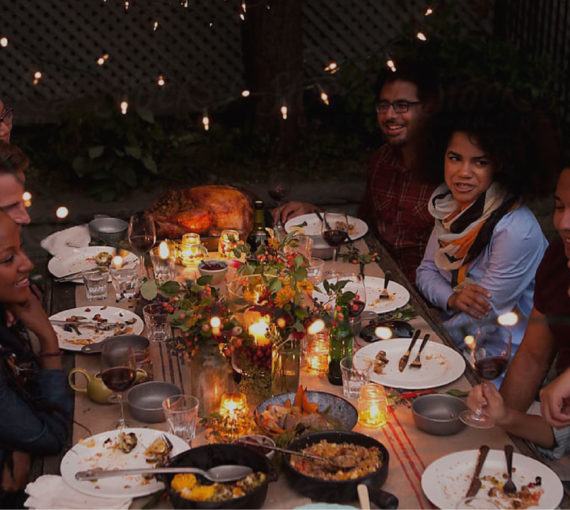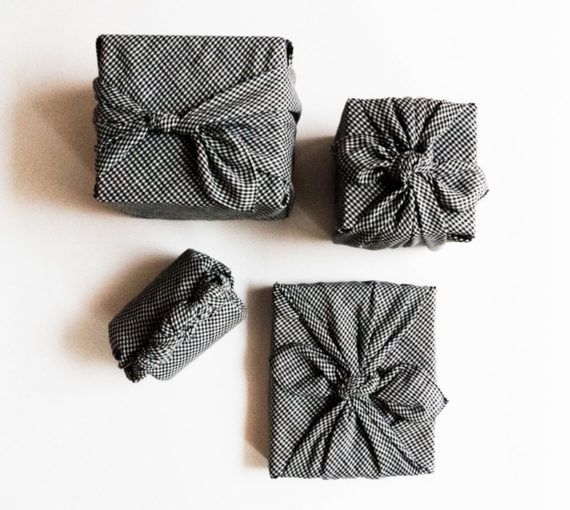
Want an eco-friendly Christmas tree? Living trees are best. Buy local. Support farms that don’t use pesticides and herbicides, and tree lots that donate to community causes. (Photo: Any Lane via Pexels)
A decorated tree is a holiday tradition for many households that celebrate Christmas. It was once common to display a real tree, but artificial tree sales have surged in recent years. Some speculate that this may be people trying to go green by saving a tree from the axe. But what’s the eco-friendlier choice — an artificial or real Christmas tree?
Artificial trees have a carbon footprint three times greater than real trees. Why? They’re made of plastic (usually polyvinyl chloride a.k.a. PVC, a toxic carcinogen you can’t recycle). They’re typically manufactured overseas, so have immense emissions from shipping. BUT — if you reuse your artificial tree for more than 20 years, it could be the greener choice.
Overall, a real Christmas tree is the eco-friendlier choice. A living tree is even better.
FIVE ECO-FRIENDLY CHRISTMAS TREE OPTIONS
Real
Buy local. Support farms that reduce or don’t use pesticides and herbicides, and tree lots that donate part of the funds to community causes. Or cut your own with a provincial permit. (In many provinces, hydro rights-of-way must be kept clear — a win-win way to meet that mandate.)
Indoor potted pine
Buy a Norfolk Island pine to keep indoors year-round in your home or workplace. A great choice for small spaces!
Rent
You order it. They deliver it. You enjoy it. They pick it up! Find a company near you.
DIY
Make a tree from items you already own — books, scrap paper, metal coat hangers, felt, etc. Search online for ideas.
Potted
If you have the space, start a Christmas tree forest! Keep the tree inside for a week (two max). Water generously. Put it outside until the spring thaw, and then plant it.

Did you know?
Some wildlife shelters accept used real Christmas trees to enhance injured creatures’ habitat. Check first to ensure you’re not giving them something they don’t need. Or get your tree to the curb for recycling or chipping day, to be used as mulch in city gardens or on a forest trail.
Photo: Paul Steeves via Wildlife Rescue Association of B.C.
Choose living Christmas trees
A living Christmas tree comes in a pot or with its root ball wrapped in burlap so you can plant it outside after the holidays. And real trees have real benefits:
- Indoor forest bathing! It smells amazing. And breathing in natural phytoncides — wood essential oils — can boost your immune system.
- Contact with nature reduces stress, anxiety, depression and blood sugar levels and makes people happy.
- If the tree’s needles are green and it’s near natural light, it’ll exhale oxygen through photosynthesis.
Try a living tree if you plan to keep it inside only for a week to 10 days AND you’re diligent at watering plants.
How to plant your living Christmas tree
Living trees don’t come with an instruction manual. Prepare yours for indoor festivities and a life outside! Here’s a list of common pitfalls, tips and tricks to help you plant a Christmas tree forest.
Most replanted holiday trees don’t survive or thrive because:
- The species isn’t adapted to the local climate (moisture, elevation, etc.).
- Big trees suffer more transplant shock.
- While inside, it dried out too many times.
- Inside too long, it lost winter hardiness.
What should I look for in a tree?
- Fir, pine and spruce are best. (Ask your local nursery.)
- Long, full branches.
- A large root ball that’s not frozen.
How do I get the tree ready for indoor life?
To reduce the shock of the warm house, leave it in a cool, slightly damp area (garage, shed or basement) a few days before bringing it inside. Keep the root ball covered with straw, peat moss or an old blanket. Water often — even add ice cubes!
What do I use for a tree stand?
Choose a container that accommodates the root ball. Pack it with sawdust, peat moss or shredded newspaper. Drape a cloth over the root ball to keep moisture in.
Place the tree near a window away from heat (e.g., vents, electric baseboards, fireplaces and wood stoves).
How do I get my indoor living Christmas tree ready for planting outside?
- After the holidays, find a place for the tree outside, exposed to minimal sunlight and winter wind.
- Pack paper bags of leaves or straw bales tightly around the root ball.
- Periodically add snow to the root ball to prevent drying out.
When the soil isn’t completely frozen…
- Dig a hole about one-and-a-half times larger than the root ball. Store the dirt in the garage (so it doesn’t freeze) until planting day.
- Gently reintroduce the tree to the cold for a week or two before planting. Keep it out of the wind, maybe in the garage.
- Remove root ball coverings (e.g., burlap).
- On a mild day, place the tree in the hole and backfill. Cover the hole with several inches of mulch and water. NOTE: To prevent suffocation, don’t plant the tree deeper than it was in the nursery pot. The top of the root ball should be one to two inches above ground level.
What about fertilizer?
Don’t fertilize living trees in winter. They’re dormant. Fertilize in the spring.
Do I need to stake the tree?
Yes. Stake to support it from strong winds so it can establish roots.

Ten inspiring lessons from trees
Trees sequester carbon, produce oxygen, regulate temperature, prevent erosion and provide wildlife habitat. Beyond their critical role in maintaining the balance of Earth’s atmosphere and biodiversity, trees can also teach us valuable lessons about the natural world and our place in it.
Eco-friendly Christmas tree decorations and ornaments
Decorating a Christmas tree together is an annual holiday tradition for many families, friend groups, households and communities. Decorating the house is a tradition across many cultures and holidays. But a lot of commercial holiday decorations are made of harmful plastics like PVC and covered in glitter (aluminum metalized polyethylene terephthalate). This fine sparkly dust is made of microplastics and harmful to the environment. Glitter takes about 1,000 years to completely biodegrade on Earth.
Use what you already have at home. Forgo buying bulk plastic ornaments, tinsel and garlands. Choose eco-friendly alternatives:
- Tinsel. Make your own from paper, recycled fabric, crafting supplies or felt. Just stitch, weave and/or tie it together. Hand cut the edges for a fringed look.
- Garlands. Craft beautiful and compostable garlands out of popcorn, cranberries and/or dried oranges. Attach durable string (e.g., cotton cord or hemp twine) to a sewing needle. Get extra crafty by creating homemade clay shapes to add. In the off-season, store garlands carefully to avoid breakage.
- Ornaments. You can use one-of-a-kind DIY ornaments year after year. Fold origami stars out of recycled paper. Create denim ornaments from worn-out jeans and stuffing from an old pillow. Try crocheting or knitting — the possibilities are endless! Search online for ideas.
- Lights. Reduce your energy consumption by switching to LED lights. They use up to 95 per cent less electricity than traditional lights.


